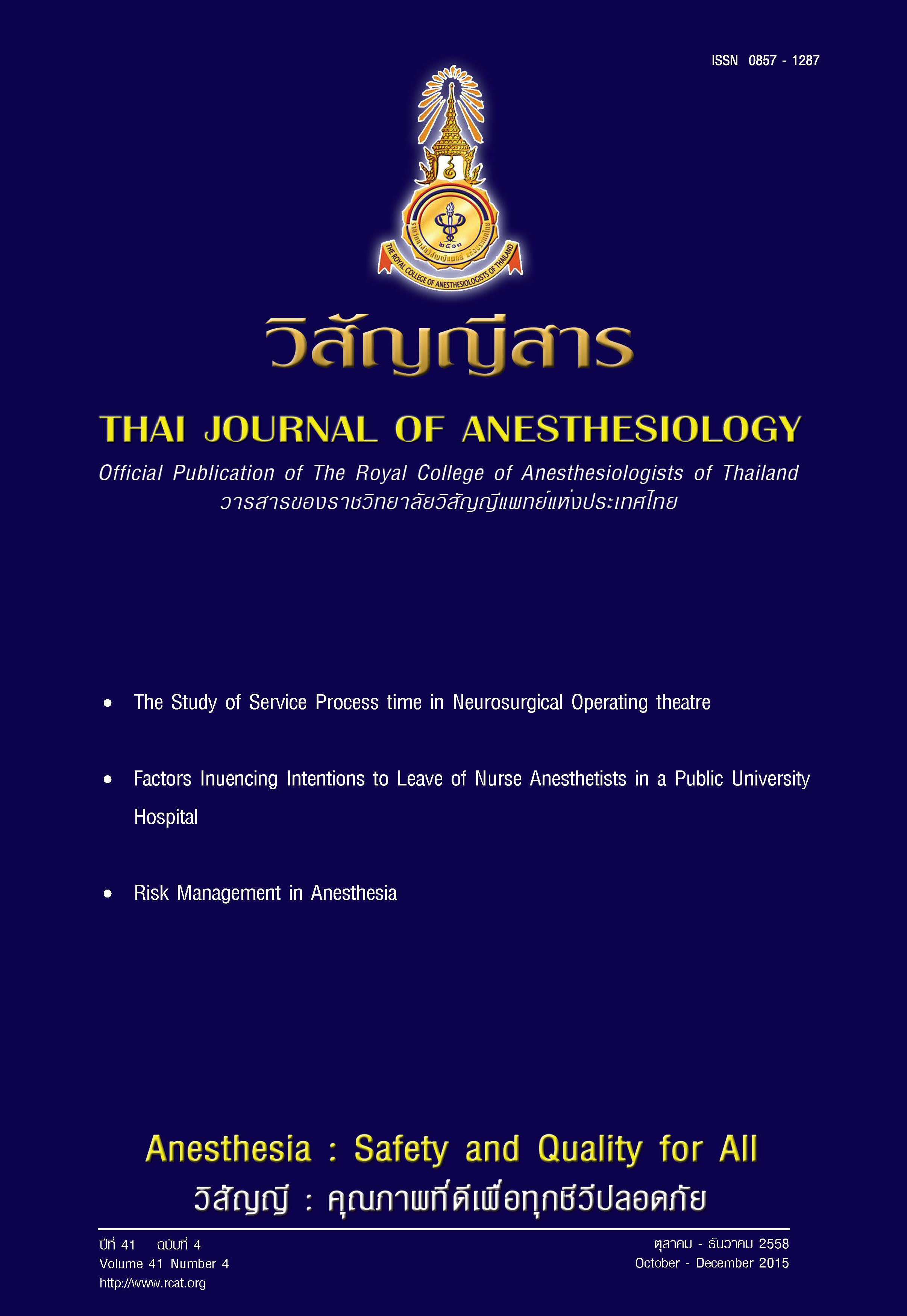Effects of Volatile Induction and Maintenance of Anesthesia (VIMA) on the patients for Laryngeal Mask Airway Anesthesia
Main Article Content
Abstract
Background: Several techniques of Volatile Induction and Maintenance of Anesthesia (VIMA) for laryngeal mask airway (LMA) anesthesia have been reported with differences in concentration of sevoflurane, breathing patterns and timing for LMA insertion. This study introduces a simple and practical VIMA technique for LMA anesthesia. Data were collected to prove the effectiveness and safety of the technique.
Methods: As a preliminary study, induction of anesthesia with vital capacity breathing of 8% sevoflurane in 100% oxygen at a gas flow rate of 6 l/min was inhaled until loss of eyelash reflex and then assisted ventilation with 5% sevoflurane in 100% oxygen was administered for 5 minutes. The technique was proved in 10 patients that it could reduce patients’ BIS down below 40. Afterward, the technique was repeated in 30 patients undergoing LMA anesthesia. The number of attempts for a successful LMA insertion and intraoperative and postoperative events were recorded.
Results: Thirty ASA classification I-II patients aged between 18-60 years were included in this study. The LMA was successfully inserted at the first attempt in 29 patients (96.67%). The average insertion time was 24.43±12.45 seconds. Two patients (6.67%) coughed during the insertion. No other complications such as breath holding, laryngospasm, desaturation and patient movement occurred. Two patients were treated with ephedrine due to systolic blood pressure decreased below 90 mmHg. Most of the patients regained recovery score of 9 or 10 within 60 minutes. No patient had postoperative nausea/vomiting.
Conclusions: This VIMA technique provided smooth LMA insertion, minimal cardiovascular effect
ผลของการใช้ยาดมสลบในการนำสลบและรักษาระดับการสลบต่อผู้ป่วยที่ได้รับการระงับ ความรู้สึกโดยใช้หน้ากากครอบกล่องเสียง
บทนำ: การใช้ยาดมสลบในการนำสลบและรักษาระดับการสลบ (VIMA) สำหรับการระงับความรู้สึก ที่ใช้หน้ากากครอบกล่องเสียง (LMA) สามารถปรับความเข้มข้นของยา sevoflurane ลักษณะการหายใจของ ผู้ป่วย และระยะเวลาที่ใช้ ได้หลายวิธี การศึกษานี้ได้นำเสนอเทคนิค VIMA ที่สะดวกและนำไปใช้ได้ง่าย จึงเก็บ ข้อมูลเพื่อศึกษาประสิทธิผลและความปลอดภัยของเทคนิคดังกล่าว
วิธีการศึกษา: เก็บข้อมูลนำร่องในผู้ป่วย 10 คน โดยนำสลบด้วย 8% sevoflurane ใน 100% ออกซิเจน 6 l/min จนผู้ป่วยเริ่มหมดสติ จากนั้นลด sevoflurane ลงเหลือ 5% และช่วยหายใจตามการหายใจของผู้ป่วยนาน 5 นาที พบว่าค่า bispectral index ลดลงจนมีค่า ประมาณ 40 จึงศึกษาต่อโดยเก็บข้อมูลผู้ป่วยอีก 30 คน เพื่อประเมินความสำเร็จในการใส่ LMA และภาวะ แทรกซ้อนระหว่างและหลังการระงับความรู้สึก
ผลการศึกษา: ผู้ป่วย 30 คน อายุ 18-60 ปี ASA classification I-II พบความสำเร็จของการใส่ LMA ครั้งแรก 29 คน (96.67%) และใช้ระยะเวลาในการใส่ LMA เฉลี่ย 24.43±12.45 วินาที มีผู้ป่วยไอระหว่างนำสลบ 2 คน (6.67%) แต่ไม่พบภาวะแทรกซ้อนอื่นๆ เช่น การกลั้นหายใจ laryngospasm desaturation และการเคลื่อนไหวร่างกาย พบผู้ป่วยมี systolic blood pressure < 90 มม.ปรอท และได้รับยากระตุ้นความดันเลือด 2 คน ผู้ป่วยส่วนใหญ่ฟื้นตัวจากการดมยาสลบภายในเวลา 60 นาที และไม่มี อาการคลื่นไส้อาเจียนหลังการระงับความรู้สึก
สรุป: การใช้เทคนิค VIMA นี้สามารถใช้ในการระงับความรู้สึก โดยใช้ LMA ได้อย่างราบรื่น มีผลต่อระบบไหลเวียนเลือดเล็กน้อย และไม่พบความล่าช้าในการจำหน่ายผู้ป่วย จากห้องพักฟื้น


